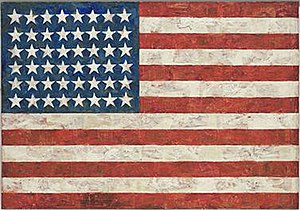Flag (painting)
This article possibly contains original research. (May 2017) |
This article needs additional citations for verification. (April 2021) |


Flag is an encaustic painting by the American artist Jasper Johns. Created when Johns was 24 (1954–55), two years after he was discharged from the US Army, this painting was the first of many works that Johns has said were inspired by a dream of the U.S. flag in 1954. It is arguably the painting for which Johns is best known.
Description[]
The work measures 107.3 centimetres (42.2 in) by 153.8 centimetres (60.6 in). It is made using encaustic, oil paint, and newsprint collage on three separate canvases, mounted on a plywood board. The painting reflects the three colors of the US flag: red, white and blue; the flag is depicted in the form it took between 1912 and 1959, with 48 white stars on a blue canton representing the then-US states (excluding Alaska and Hawaii), and with thirteen red and white stripes. Newsprint is visible under the stripes. Reading the texts, it is clear that the newsprint was not selected at random: Johns steered clear of headlines, or national or political news, and used inconsequential articles or adverts. The painting has a rough-textured surface, and the 48 stars are not identical. It is dated 1954 on its reverse.
Johns's selection of the US flag allows him to explore a familiar two-dimensional object, with its simple internal geometric structure and a complex symbolic meaning. Johns was attracted to painting "things the mind already knows," and claimed that using a familiar object like the flag freed himself from the need to create a new design and allowed him to focus on the execution of the painting. Critics were unsure whether it was a painted flag or a painting of a flag; Johns later said it was both. His work is often described as Neo-Dadaist and anticipates aspects of pop art, minimal art, and conceptual art.
History[]
The painting was included in Johns's first solo exhibition at the Leo Castelli Gallery in early 1958. Alfred Barr, director of the Museum of Modern Art, wanted to buy the work, but was concerned that it might be considered unpatriotic. He persuaded a friend, Philip Johnson, to buy it instead; Johnson bought it, and donated it to the Museum of Modern Art "in honor of Alfred H. Barr, Jr." when he retired in 1968.
Flag Series[]
Johns made over 40 works based on the US flag, including a large and monochrome White Flag in 1955, and his 1958 work Three Flags with three superimposed flags showing a total of 84 stars.
Jasper Johns's 48-star Flag from 1958 was purchased in 2010 by hedge fund manager Steven A. Cohen for an estimated $110 million, making it the most expensive painting ever by a living artist.[1]
In November 2014 the encaustic Flag (1983) was auctioned off for $36,000,000 at Sotheby's New York.[2]
References[]
- ^ Carol Vogel (18 March 2010). "Planting a Johns 'Flag' in a Private Collection". New York Times. Retrieved 2 October 2020.
- ^ Joe Tacopino (12 November 2014). "Jasper Johns' American flag painting sells for $36M". New York Post. Retrieved 2 October 2020.
| External video | |
|---|---|
Further reading[]
- American Culture in The 1950s Martin Halliwell, p. 203-205
- https://web.archive.org/web/20120622185114/http://edu.warhol.org/app_johns.html
- Figuring Jasper Johns, Fred Orton, p. 89-146
- Made in U.S.A.: An Americanization in Modern Art, the '50s and '60s, Sidra Stich, p. 19
- The Target: Alain Robbe-Grillet, Jasper Johns, Ben Stoltzfus, p. 80-81
External links[]
- Flag, Museum of Modern Art
- Jasper Johns (born 1930), Metropolitan Museum of Art
- 1954 paintings
- Paintings by Jasper Johns
- Paintings in the collection of the Museum of Modern Art (New York City)
- Flags in art
- Flags of the United States